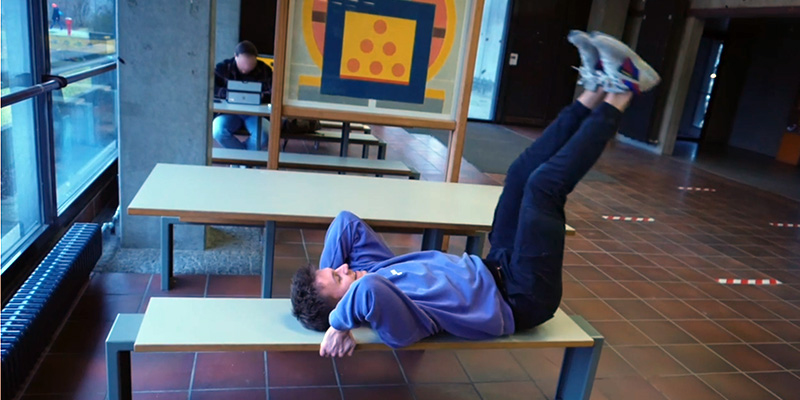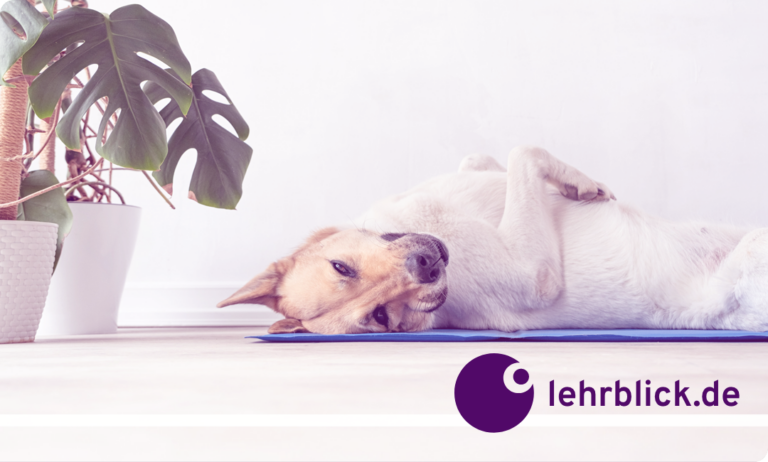We’re sure most of you are more than familiar with this situation: after hours and hours of sitting at your desk or in the lecture hall, everything grinds to a halt and your body and mind are barely functioning. Your back is hunched, your head aches and all concentration has gone out of the window. But did you know that sitting for a long time not only affects our health temporarily but can even make us ill in the long term? And that most of us spend far too much time sitting down? In this blog post we explain why sitting for too long makes you ill and why it’s important to take exercise breaks.
We sit – all over the place and for far too long
We sit and we sit and we sit: while eating our breakfast in the morning, in the car or the bus on the way to the university, at our desk, in the lecture hall or seminar classroom, in the canteen, on the way home, then at the dining table and on the sofa in the evenings. Adults spend around eight to ten hours a day sitting down. A survey of 3756 students at the University of Regensburg has confirmed these figures (Weber et al., 2023). According to this survey, students spend around half of their daily sitting time (that’s around four hours a day) sitting down at the university. They – like many people who have a higher level of education – are therefore among those in our society who sit down a lot.
Just cast your mind back and review your last working day and think of every opportunity you took to sit down: when you were out and about, when you were at the university and when you were at home. Where have you already sat down today, and how long did you sit for? You can probably think of far more moments in your daily life where you were sitting down than you were previously aware of, can’t you?
Those who sit for a long time die younger
So why all these annoying questions about sitting for a long time? Sitting can be really comfortable after all. And when it comes down to it we have had extensive training in how to sit still for a long time ever since we first started school – and no one ever told us about the risks and side-effects of sitting for a long time in the process either. No wonder, because ‘sedentary behaviour’ – the term for behaviour involving sitting or leaning with low energy expenditure – is a relatively new field of research.
That is why so far many people are unaware that sitting uninterruptedly for long periods of time poses a health risk. Sometimes it is said that those who sit for a long time die younger – and that is actually true! People who sit a lot are at greater risk of dying younger than those who spend less time sitting down. First and foremost, however, sitting for a long time can make you ill: it increases the risk of getting common diseases like type 2 diabetes mellitus, cardiovascular disease or cancer. A team of scientists at the Institute of Epidemiology and Preventive Medicine at the University of Regensburg are also conducting research into this issue. They have discovered that the risk of endometrial or ovarian cancer is around 30 per cent higher among women who spend a lot of time sitting down (Hermelink et al., 2022). The risk of bowel cancer is significantly higher for both men and women.
Does sport protect people from the risks of sitting for too long?
If you now think you are on the safe side if you go and train at the fitness studio twice a week (or sit in the car to drive there?!), we’re sorry, but we are going to have to disappoint you. Although any kind of exercise and sports activity is good for your health, the amount of exercise is generally not enough to compensate for the negative consequences of sitting for a long time, particularly as regards those who spend a lot of time sitting down (Ekelund et al., 2019). Anyone who sits for eight hours a day or longer would have to break a sweat physically for at least an hour a day in order to effectively counteract the health risks of sitting for a long time. What would be simpler than fitting in an hour’s jogging every day would probably be to take more frequent breaks from sitting during your daily life.

Less sitting (still) and more exercise: tips and tricks for daily life at university
There are many ways to take frequent breaks from sitting for a long time in your daily life at work or at university (Jochem & Leitzmann, 2018). You could definitely stand or walk around while doing activities like reading or talking on the phone, for example. Just try it! And don’t be shy of suggesting to your colleagues that you hold a meeting with everyone standing or walking. Sometimes it can also be helpful to outsmart yourself by doing small things: put your phone, your waste paper basket or anything else you use frequently so far away that you can’t just reach it from where you are sitting but have to get up briefly and take a couple of steps to get to it. Instead of sending an email to a colleague, you could walk over to their office perhaps. You can also use the regular walks you take to get drinks, go to the toilet or go over to the printer to actively break up long periods of sitting.
If you do have to sit, do it as dynamically as possible
There are, however, situations where you can’t avoid sitting down. Due to safety reasons and convention, we have to sit down in lecture halls or on the bus, for example. In that case it is important to sit with a straight back, keep sitting for as little time as possible and alternate between sitting and standing or moving around. When you are at your desk, a brief exercise break after 30 minutes is not only good for the body but pleasing for the mind as well. When you are sitting, it is not so much what you’re sitting on that is important but primarily how you are sitting. Here, the magic words are “dynamic sitting”, which includes changing your position, shifting your weight or rolling your shoulders frequently – anything that moves the body (Starrett et al., 2016). Office chairs with movable back- and armrests facilitate dynamic sitting but are no substitute for real exercise. Height-adjustable desks are also suitable for structuring the daily routine at the office so that it is varied. You should change from a sitting to a standing position after about 20 to 30 minutes – and vice versa, as standing in a static position for too long can also lead to health disadvantages. However, it is much easier to add movement while you are standing – by shifting your weight, rotating your hips or doing stretching exercises, for example. Furthermore, it is advisable to set one foot higher than the other – on a footstool, for instance – in order to relieve the spine. And one more tip: why not sit cross-legged or in the lotus position on the floor or the sofa to watch TV now and then? That boosts flexibility, stabilises the spine and stops you from turning into a couch potato in front of the screen.
Teaching: doomed to sit still?
A colleague once said that the students’ kinesic behaviour in class was “verging on apparently dead”. And she wasn’t wrong, because sitting is absolutely obligatory in class. Due to the seating or because of convention, it is often the case that not even dynamic sitting is possible or desired in lectures or even seminars, because by the time we reach secondary school – if not sooner – we have learned to sit when we are learning and to do so as quietly as possible, and we have got used to that! Do you ever find yourself admonishing your children to just concentrate for once if they are fidgeting in their chairs when they are revising vocabulary or doing their homework lying on the floor, for example, or assuming your students are unfocused if they tap their feet or stretch out their arms and legs? We (subconsciously) perceive focused learning and movement as being a contradiction in terms and assume that you have to be calm and in a sitting position to take in information and process it further.
Teaching that involves exercise boosts performance
Cognitive science and learning research do not give occasion for this perception at all, however: in fact, various studies (Rupp et al. 2020; Rupp 2022) have shown that teaching involving movement or exercise breaks in class has a positive effect on both cognitive performance and academic productivity. This is not all that remarkable, as concentration and attention dwindle perceptibly after about 20 minutes of front-of-class teaching – which is how lectures are usually held. That is not good for either the students or you, who have to teach while trying to work against students’ increasing restlessness and bleary gaze. Accordingly, an exercise break during the lecture or seminar does not constitute a loss in teaching/learning time either. Instead, you are rewarded with students who are awake and focused and who are now better able to engage critically with what you are teaching and contribute to it! Thus, exercise during teaching both promotes health and optimises learning performance!
Even though teaching that involves exercise is only one of the many aspects to consider in order to create a university setting that is more exercise-friendly and therefore healthier, currently, most of the examples of exercise-friendly teaching definitely come from practice (Rupp et. al. 2020; Projekt FAUbewegt 2023).

Exercise breaks in teaching
The most common version is to interrupt the teaching with three- to five-minute exercise breaks. As not all lecturers feel called to demonstrate physical exercises in front of their students and many also lack ideas and knowledge in this regard, the University of Regensburg sports centre has made videos for breaks which can be accessed from the University of Regensburg’s “Mediathek”. The videos can be integrated as a link in lecture slides, for example, and then only have to be played for students to take a break from sitting down (and you have to join in too, of course, or there’s no point 😉 ).
Exercise break videos 1-3 were recorded in a lecture hall on purpose so that it is immediately evident that the exercises can also be done in the narrow rows of seating.
However, exercise breaks are not only helpful during lectures but also to break up learning periods at home, for example. Therefore, there are also videos of exercises that you can do at your desk or in a seminar classroom (videos 4-7). All the videos are designed so that you do not need to wear sports gear.
The campus as a fitness studio
Besides lecture halls and seminar classrooms, there are also exercise options to be found at many other locations on campus: to point these out, students from the sports centre have made videos in different places at the University that show how easy it is to integrate exercise into daily life at the university. You can also use those ideas and videos for an exercise break in your courses: what if you were to interrupt your lecture or seminar briefly and send all the participants outside to walk or run up and down the steps?
You can also go to UR alive, the web page about student health management at the University of Regensburg, to find more ideas for teaching involving exercise and also for synchronising methods, exercise and the learning process so that the actual teaching does not have to be interrupted.
References
Ekelund, U., Brown, W. J., Steene-Johannessen, J., Fagerland, M. W., Owen, N., Powell, K. E., Bauman, A. E., & Lee, I.-M. (2019). Do the associations of sedentary behaviour with cardiovascular disease mortality and cancer mortality differ by physical activity level? A systematic review and harmonised meta-analysis of data from 850 060 participants. British Journal of Sports Medicine, 53(14), 886–894. https://doi.org/10.1136/bjsports-2017-098963
Hermelink, R., Leitzmann, M. F., Markozannes, G., Tsilidis, K., Pukrop, T., Berger, F., Baurecht, H., & Jochem, C. (2022). Sedentary behavior and cancer–an umbrella review and meta-analysis. European Journal of Epidemiology, 37(5), 447–460. https://doi.org/10.1007/s10654-022-00873-6
Jochem, C., Leitzmann, M., & Traidl, S. (2018). Sitzstreik: Tipps und Tricks gegen die Risiken und Nebenwirkungen des Sitzens. Herder.
Projekt FAUbewegt (2023). Handbuch der bewegten Lehre. Friedrich Alexander Universität.
Rupp, R., Dold, C., Bucksch, J., & Huneke, H.-W. (2020). Bewegte Hochschullehre: Einführung in das Heidelberger Modell der bewegten Lehre. Springer.
Rupp, R. (2022). Online-Seminare bewegt gestalten: Mit Schwung durch den Online-Marathon. Springer.
Starrett, K., Cordoza, G. & Starret, H. (2016). Sitzen ist das neue Rauchen. RIVA Verlag.
Weber, A., Kroiss, K., Reismann, L., Jansen, P., Hirschfelder, G., Sedlmeier, A. M., Stein, M. J., Bohmann, P., Leitzmann, M. F., & Jochem, C. (2023). Health-promoting and sustainable behavior in university students in germany: A cross-sectional study. International Journal of Environmental Research and Public Health, 20(7), 5238. https://doi.org/10.3390/ijerph20075238
Suggestion for citation of this blog post
Jochem, C., Weber, A. & Engels, U. (2023, May 18). We exercise smart minds – Exercise breaks in teaching for more concentration, more fun and better health.. Lehrblick – ZHW Uni Regensburg. https://doi.org/10.5283/zhw/20230518.EN

Dr. Andrea Weber
Dr. Andrea Weber studied nutritional science and public health. Since 2017, she has been conducting research at the Institute of Epidemiology and Preventive Medicine at the University of Regensburg into the questionnaire- and device-based measurement of physical activity and into the connections between lifestyle factors and the risk of cancer. In the NAKO health study she is responsible for several modules concerning physical activity and is the spokeswoman for the panel of experts concerned with physical activity and fitness.

Dr. Carmen Jochem
Dr. Carmen Jochem is a medical scientist who works at the Institute of Epidemiology and Preventive Medicine at the University of Regensburg as a research assistant. The focus of her research is on the areas of lifestyle factors and cancer, and also public and planetary health. She has published several books, including “Sitzstreik: Tipps und Tricks gegen die Risiken und Nebenwirkungen des Sitzens” (Sit-down strike: Tips and tricks for combating the risks and side-effects of sitting) (Herder Verlag, 2018), which she co-authored with Prof. Dr. Dr. Michael Leitzmann.

Dr. Uta Engels
Dr. Uta Engels is a sports science graduate and manages the University of Regensburg sports centre. Her key focus lies in university sport and university health management and also on the question of the significance that exercise has for growing up, learning, living and working healthily. She is a systemic consultant and trainer in communication and motivating conversation techniques, she is the author of several textbooks and she offers talks and advanced training for different occupational groups.





